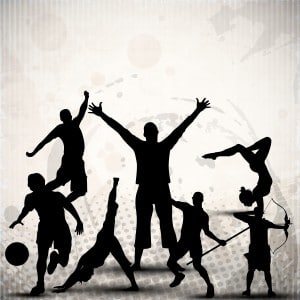 Preventing eye injuries when you least expect them – More than 40% of all eye injuries are due to sports or recreational activities each year.
Preventing eye injuries when you least expect them – More than 40% of all eye injuries are due to sports or recreational activities each year.
After the work day is done and school is out, do you stop thinking out the safety of your eyes and your children’s eyes? If you answered yes, you are not alone. Each year, thousands of Americans suffer eye injures while enjoying sports and leisure activities. In fact, according to the National Eye Institute (NEI), every 13 minutes, a sports related injury is being treated in a U.S. emergency room. If you are one of over 200 million people who will be participating in a sports-related activity this year, you can do your part to prevent eye injuries this year when you least expect them simply by being prepared.
You may believe it will never happen to you but everyone runs the risk of a serious eye injury while playing sports. Hockey lovers may remember when Steve Yzerman suffered his serious eye injury during the Western Conference semifinals in 2004. A puck to the eye scratched the all-stars cornea and broke the bone just below his eye, requiring surgery. While hockey may be an obvious choice for eye injuries, virtually any sport or leisure activity may pose an unexpected risk including baseball, skiing, basketball or even tennis. The best way to protect your eyes this summer is to simply put on eye protection.
While regular eyeglasses may prevent some minor injuries, they are not sufficient protection and should not be considered to be enough for anyone playing sports this summer. While many sports have standards which are put in place to protect your eyes, sometimes these rules may become a bit relaxed, to the detriment of those playing. Typically the eye safety standards are as follows:
- ASTM F803: Eye protectors for selected sports (racket sports, women’s lacrosse [see the U.S. Lacrosse website for more details], field hockey, baseball, basketball);
- ASTM F513: Eye and face protective equipment for hockey players;
- ASTM F1776: Eye protectors for use by players of paintball sports;
- ASTM F1587: Head and face protective equipment for ice hockey goaltenders;
- ASTM F910: Face guards for youth baseball; and
- ASTM F659: High-impact resistant eye protective devices for Alpine skiing
Protective glasses or goggles with UV protection should be worn when snow or water skiing. They will help shield the eyes from sunburn and glare.
Source: http://www.geteyesmart.org/eyesmart/living/eye-injuries/protective-eyewear.cfm
Note: If you suffer an eye injury while playing sports this summer, it is important that you get treatment right away, even if the injury seems minor. This is especially important when dealing with our children as they are still growing and may be particularly vulnerable to injuries.
This summer, do what you can to reduce the number of eye injuries by protecting your eyes and the eyes of those you love. Even if eye protection is not required, be smart, wear it. Protect your eyes, they are worth it.
